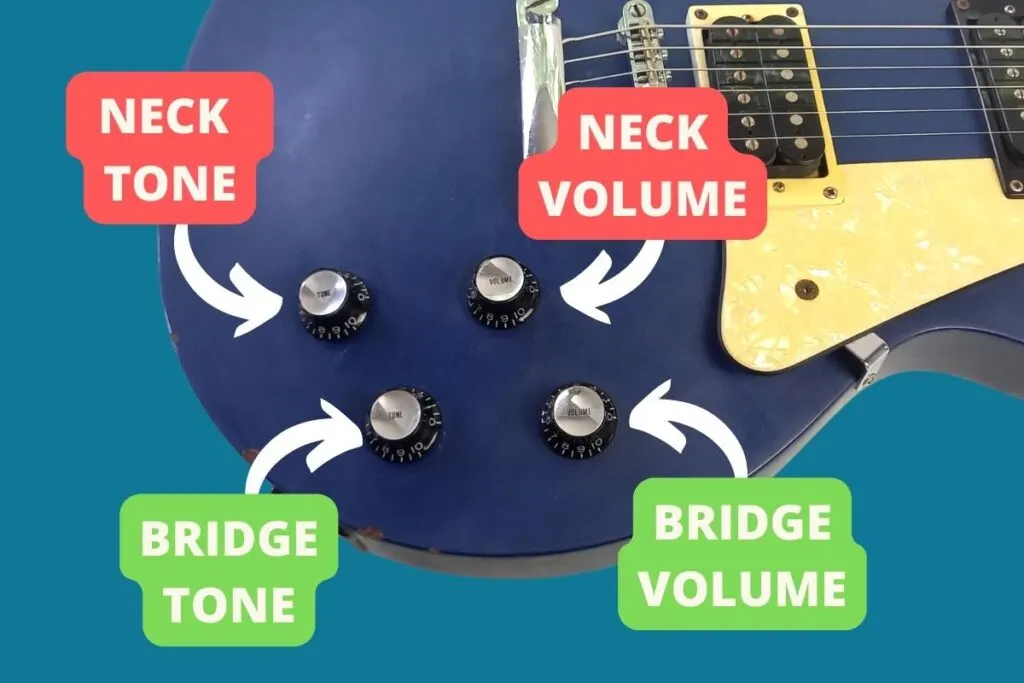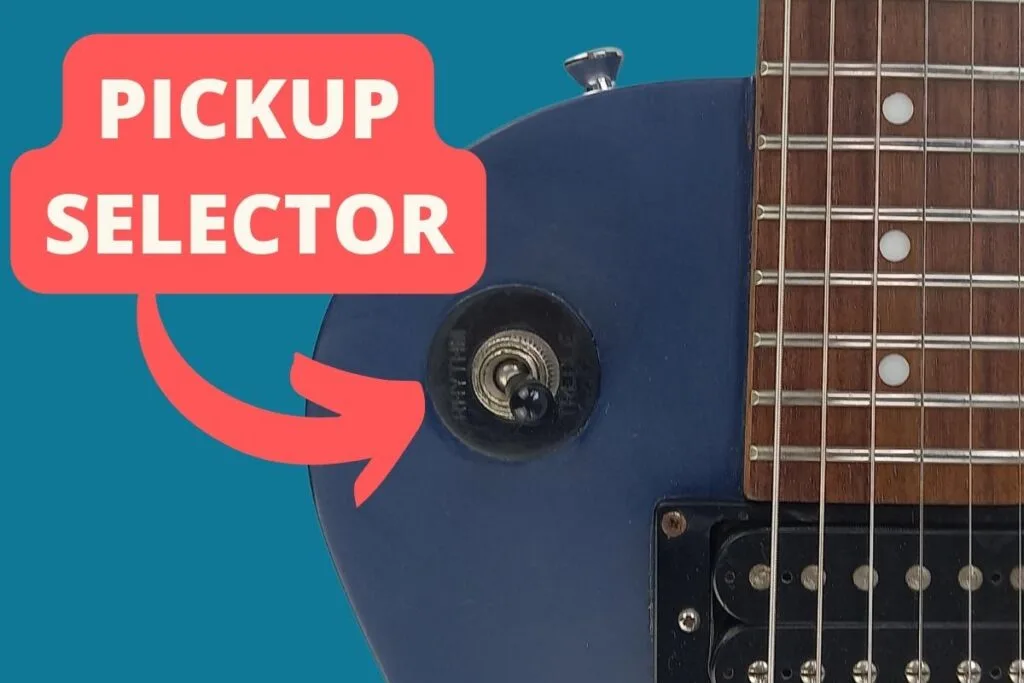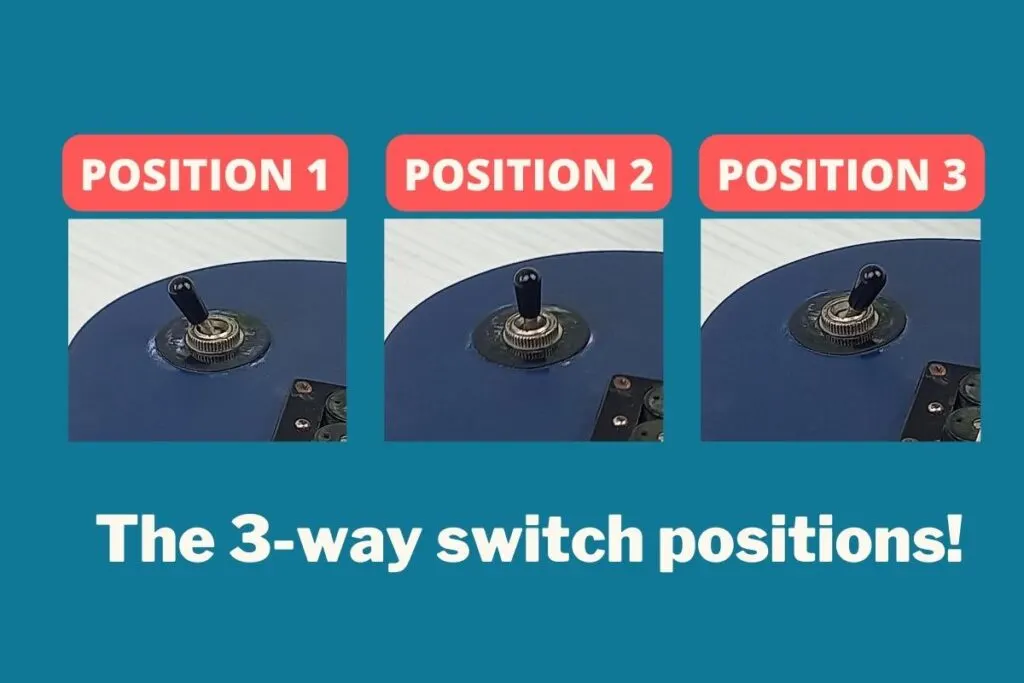The Les Paul is an iconic guitar model that’s loved by professionals and beginners alike. It’s vast array of different knobs and switches makes it incredibly versatile. But, have you wondered what the different Les Paul knobs do?
The Les Paul electric guitar has four knobs: two for volume and two for tone. For the standard specification of Les Paul: one volume and tone knob controls the neck pickup, and the other volume and tone knob controls the bridge pickup.
But this isn’t all. In fact, a lot of newer Les Paul guitars come with coil-tapping controls. And, let’s not forget about the pickup selector!
Let’s take a look at all different knobs and controls and a Les Paul, and how to use them effectively to get the best sound from your guitar.
The Les Paul knobs explained
The Les Paul has four knobs, arranged in a “diamond” like pattern. The two knobs closest to the neck of the guitar are the volume knobs. The knobs closest to the bridge are the tone knobs. The two knobs on the top row (closest to the strings) control the neck pickup, and the two knobs on the bottom row control the bridge pickup.

The Les Paul’s tone knobs
The Les Paul has separate tone knobs for each of its pickups. The tone knobs are located closest to the bottom of guitar’s body, with the neck pickup’s tone knob at the top and the bridge pickup at the bottom.
When you have the pickup selector set only to use the neck pickup, the bridge pickup’s tone knob won’t affect the guitar’s sound since the bridge pickup is disabled, and vice versa. If you set the selector knob to the middle, both tone knobs will affect the guitar’s sound since both pickups are active.
What the tone knobs do
The purpose of the tone knobs is to change the intensity of the high-end (“treble”) frequencies of your Les Paul’s guitar signal. A lower tone setting reduces the treble frequencies, making your guitar sound slightly deeper with less brightness to the tone. Adjusting the knob to higher levels will make the sound brighter and sharper.
It’s important to note that these knobs don’t affect your guitar’s lower end (“bass”) frequencies at all, only the treble. However, lower treble levels make the bass sounds come through more clearly – making it sound as if you increased the bass.
Take a listen to this audio example. All I’m doing is strumming a chord and turning the tone down and up again.
There’s a massive tonal difference between the two – you can imagine how many possible sounds you can get out of the settings between zero and ten!
Here’s a more detailed article that covers the science behind it, if you’re interested.
Since there are two tone control knobs, you can adjust the tone for both your neck pickup and the bridge pickup separately. Setting both to their highest setting will give you a crisp, lead guitar type of sound, while the lowest settings will output a mellower, bass sound that’s perfect for jazz, hard rock, and some metal genres.
Another key use of the tone knobs is to adjust your guitar’s sound between live performances and indoor, studio-type settings. Higher volumes can cause too much treble to sound terrible, but you can easily change that on the fly using the tone knobs. But it’s just as easy to set the style back to full-blast treble when you need that extra brightness in your sound.
My opinion: There is so much tonal variety that you can get from a Les Paul if you take the time to experiment with the different knobs and settings! They’re an incredible tool that’s unfortunately underused by a lot of guitarists.
The Les Paul volume knobs
Unlike guitars like the Stratocaster, the Les Paul doesn’t have one central volume knob. Instead, it has two separate volume knobs: one for each pickup.
The volume knobs are located next to the tone knobs, just to the left if you’re looking at your guitar from the playing position, slightly further away from the bridge and closer to the neck. Like the tone knobs, the one on top is for the neck pickup, while the one below is for the bridge pickup.
The great thing about having two separate volume knobs is that you can adjust the two pickups separately. If you have the pickup selector set to use both, you can adjust the volume to give you more of the bright, sharp sound of the bridge pickup, with a lower setting for the neck pickup just to have the mellow, warm undertones or the other way around if that’s what you prefer.
Nothing’s stopping you from setting both to full blast, of course! You’re the guitarist, so you make the rules. Still, it’s great to have the flexibility to explore different variations of the settings to get the perfect, unique sound you’re looking for.
Remember, higher volume doesn’t always mean better. High volumes can easily create noise over speakers or recordings, so it’s crucial to learn how your volume knobs sound at different settings.
The Les Paul guitar’s pickup selector
The Les Paul was designed and is still manufactured by Gibson Guitar Corporation, but a few other companies manufacture clones of it. Epiphone and Tokai make the two most popular clones, but there are many others. They all have the same basic set of features, though, including the pickups and the pickup selector.

The Les Paul’s pickups
To understand the Les Paul’s pickup selector, it helps to understand the purpose of each pickup. The Les Paul has two humbucker pickups. These differ from the single-coil pickups used on guitars like the Fender Stratocaster, since it’s basically two pickups in one. Humbuckers reduce external noise and create a fuller, warmer sound with less of the brightness of single-coils.
The two humbuckers on the Les Paul are located at the two extremes of the guitar body’s playing area. One is located at the neck of the guitar, and the other is at the bridge. Each pickup detects a different range of string vibrations which (coupled with their slightly different wirings) leads to a unique sound from each pickup.
The bridge pickup has a brighter and sharper tone popularly used for lead guitar. Rock or metal guitarists love to use this setting when playing lead guitar or solos, especially with overdrive or distortion. The neck pickup’s tone is more mellow and warm. It is perfect for everything from mellow jazz licks, grinding riffs, and rhythm guitar.
Using the pickup selector (3-Way Switch)
The pickup selector knob on the Les Paul has three positions. They help you select which pickup (or pickups) you want to use while playing since they produce different sounds. What’s unique about this pickup selector is that its positions are marked with either “Rhythm” at the top position, or “Lead” at the bottom. The pickup selector’s positions are:
- With the switch set to “Rhythm,” only the neck pickup will be used. This will give you the warmest, most mellow tone. The tone is designed to blend in better in a band setting, hence the word “Rhythm.”
- Moving the selector switch to the middle will let you use both the neck and bridge pickups simultaneously. It will give you a tone that’s perfectly in the middle between the two extremes while providing an excellent mixture of both. It creates a full sound that’s pretty hard to duplicate on another guitar.
- The third position is the one that’s labelled “Treble.” This one will use only the bridge pickup; the neck pickup will be disabled. This position gives you the brightest tone and is the ideal setting for players who like to play anything from blues, rock, and metal guitar.

Top tip: Here’s something fun to do. Turn the neck pickup volume to zero and the bridge pickup to ten. Then, set the pickup selector to the middle position and play and open string. Now, move the pickup selector back-and-forth between the middle and “Lead” position. This effect can be used to create interesting rhythmic leads, like the guitarist Tom Morello.
Les Paul coil-tapping and coil-splitting
Some modern Les Paul models have a function called “coil-tapping”. This is often confused with “coil-splitting”, which is a less common feature. Let’s take a look at both, and clear up any confusion!
What is coil-tapping?
All guitar pickups are made using a coil of copper wire that generates a signal from the guitar strings, and sends it to your guitar’s output. A coil-tapped pickup has two outputs: one output that uses the full length of the copper coil, and another that uses a bit less of the copper coil. This second output has a slightly weaker signal, which emulates the sound of older “vintage” style pickups.
Any Les Paul that’s set up with coil-tapping will be able to switch freely between the two settings, giving you a lot of tonal options!
How to use coil-tapping on a Les Paul
Coil-tapping can be activated and deactivated while playing simply by pulling out the specialised volume knobs for the two pickups.
The default Les Paul setting has all of the knobs pushed in. With that setting, your guitar will make full use of both humbuckers. If you pull out the volume knob for the neck pickup, you will activate coil-tapping for that pickup specifically, and similarly for the bridge pickup’s volume knob.
You can activate coil-tapping for both pickups simultaneously by pulling both volume knobs out, getting you as close to the sound of a single-coil guitar as a Les Paul can get, or you can activate it on only one pickup to get a unique humbucker-single-coil mix.
Coil-tapping isn’t everyone’s cup of tea. Some guitarists argue that if they wanted a single-coil sound, they would just get a single-coil guitar! But the fact that the Les Paul can give you this sound without sacrificing the noise filtering aspect and full, warm mid-tones of the humbuckers makes it an excellent feature for others. It’s also handy option if you’re on a budget!
What is coil-splitting?
Coil-splitting is a setting that essentially disables half of the humbucker pickup, turning it into something similar to a single-coil pickup. When you activate coil-splitting, your guitar will have a tone that’s a bit closer to that of single-coil guitars, like a Fender Stratocaster.
The Les Paul does this in such a way that it keeps the noise reduction qualities and warm mid-tones of the humbuckers while adding the dynamic character of single-coils. Coil-splitting can be a nice touch when you’re playing some lead guitar solos or other types of music requiring a single-coil guitar’s more intense tone!
Not many Les Paul models come with coil-splitting. But, if you’re handy with a soldering-iron, it is something that you can do yourself.
Are the knobs the same for all Les Paul models?
After more than 60 years, there are so many Les Paul models that it’s impossible to say all models are the same. For example, the popular Epiphone Les Paul range is similar to Gibson, manufactured with a full Gibson license, but there can be some differences in how their controls work. The same applies to Gibson’s own Les Paul models.
The two most common differences you’ll encounter have to do with coil-tapping and volume or tone control knobs.
Not all Les Pauls have coil-tapping. You can test yours to see if you can easily pull out the volume knobs. Your guitar has coil-tapping if it comes out easily with a satisfying “click” sound. If you need to use a hammer or screwdriver to pull it out, you’re doing it wrong, and your guitar probably doesn’t have coil-tapping.
The second possible difference is in the number of control knobs. Most Les Paul models come with the four knobs we’ve discussed so far, but there are a few models with only two knobs. If this is the case, both knobs will control both pickups simultaneously; one will control the tone, and the other will be the volume.
It’s not that any one model is sub-standard. It depends on the guitarist’s needs and what they want to play.
What’s the best settings for a Les Paul?
The best setting for a Les Paul is what sounds best in the moment! Probably not the answer you’re looking for, right? What if I told you that I can teach you how to get the right setting every time?
It’s really simple. Use the exercises below to learn how to use to the volume and tone knobs to get the full tonal variety out of your Les Paul, and really change the way you play.
Exercise 1: Learning the volume knob
Set your volume knob to zero. Try turning it up very slightly and play something. Listen to how it sounds. Now, turn it up a little bit more and play the same thing. Repeat until you find a setting that sounds good to you. This is the volumes “sweet spot”.
Exercise 2: Learning the tone knob
Set the tone knob to zero. Now, play something and listen to how it sounds. Next, turn it up and play the same thing. Again, repeat this until you find what sounds good to you. It’ll change depending on the room, amp settings, and your mood!
Exercise 3: Learning the pickup selector
Set your tone and volumes to max. Set the pickup selector to the neck position and play something. Now, move it to the next position and play the same thing and compare the two. Finally, set it to the final position and try it out. Keep trying the different positions to learn how they sound. Combine this exercise with the other two to really learn how varied each pickup can sound!
Conclusion
The Les Paul is an iconic and highly popular guitar. You can hardly watch a rock or metal music video without seeing at least one!
Its success speaks for itself and is mainly due to the dynamic variety of tonal options and settings you have at your disposal to create the sound you want. Play around with the knobs and find your perfect setting or settings. Be an artist and experiment freely!


Conor is a music producer, multi-instrumentalist, and all-round enthusiast from the UK with over 15 years of experience. He’s the founder and sole-content creator for the roundtable audio blog and YouTube channel.
